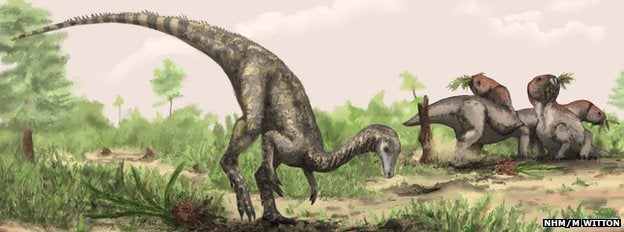Scientists Might’ve Discovered World’s Oldest Dinosaur
Paleontologists aren't quite sure yet, but a new species of dinosaur--if it is actually a dinosaur--appears to be the oldest ever found, predating the existing oldest dinosaur by 15 million years.

Paleontologists have discovered what very well might be the oldest known dinosaur, if in fact Nyasasaurus parringtoni is a dinosaur at all. A study published in the journal Biology Letters is describing a new species of prehistoric reptile that appears to predate the previous earliest-known dinosaur by 10 to 15 million years. That not only stands as a new superlative in dinosaur classification, but if confirmed, it fills a gap in the evolutionary timeline that’s been puzzling scholars for years.
Nyasasaurus parringtoni is a fairly small relative of the massive reptiles we’ve come to associate with the word dinosaurs. Measuring between 6 and 10 feet long, it walked semi-upright on two legs and weighed somewhere in the vicinity of 45 pounds to 130 pounds–a wide range, we know, but considering researchers are working with just one upper arm bone and six vertebrae, all of these figures are assumed to be very rough approximations.
Far more important than precise physical specs is the dinosaur’s age. The early evolution of dinosaurs is kind of tough to parse, particularly because there were a lot of reptiles on Earth at the time, some of which may have evolved dinosaur-like traits independent of the dinosaurs. Discerning the difference using only the fossil record as a guide is difficult, but the researchers authoring the paper maintain that a few of the features they have extrapolated from their skeletal specimens suggest very strongly that it is indeed a dinosaur–and the earliest one yet discovered.
If they are correct, Nyasasaurus parringtoni would fit right into a hole in the evolutionary chain of events, dating to right around the time paleontologists think dinosaurs split off from their oldest relatives and became the distinct group that would later go on to dominate the Earth for 100 million years. That means that perhaps Nyasasaurus parringtoni is the oldest dinosaur ever discovered, or maybe that it’s not (the research team itself has stopped short of formally making that claim based on the incompleteness of the skeleton, though the evidence they put forth suggests that it is). Either way, the species is a key piece in the puzzle of dinosaur evolution, one that would’ve shared the planet with dinosaurs’ oldest known relatives and that very well may have kicked off the age of the dinosaurs.